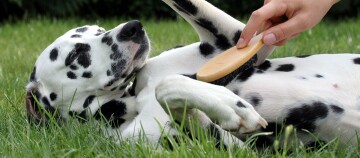Flying with a Dog: How to Properly Plan and Prepare Your Dog for a Flight!
07.10.2022 - Reading time: 5 minutes

What could be better than spending the best time of the year with your four-legged companion? This is relatively easy by car or train. When flying with a dog, however, there is a lot to consider before the journey begins. You should also bear in mind that a flight can be stressful for your pet. Some breeds like bulldogs, and older dogs in general should not fly for health reasons. Read here which factors need to be considered so that you can fly with your dog without worrying!
Proper planning for flying with a dog
Each airline has its own transport requirements for dogs that generally depend on the size, weight and sometimes the breed of the dog.
Small dogs often are lucky enough to be allowed with you into the cabin. For this, you need special dog bags in the required shape and size that are entirely enclosed and, naturally, well-ventilated. Read more about this below.
Mid-sized and large, but especially heavy, dogs can only fly in a transport box in the hold. For most airlines, this applies from eight kilograms.
Furthermore, you must understand that flying in the hold is pure stress for any dog. It is therefore extremely important that you prepare your dog properly and get him used to the required transport box weeks or months in advance. Find out in good time whether your airline allows your dog’s breed. Breeds excluded from transport include Pugs, Bulldogs and Boxers, i.e. breeds with flat noses or breed-related shortened muzzles. These breeds have difficulties getting sufficient air when hot or stressed and are also considered to be especially susceptible to stress.
With regard to the general health and resilience of your dog, consult your vet. Last but not least, you should find out what the entry requirements are for your destination country. Find out what vaccinations at what time intervals your dog requires and whether there may be quarantine regulations. Within the EU, an animal must have an EU pet ID, be chipped and be vaccinated against rabies.
Read all about this in the Maxi Zoo guide “Entry requirements for dogs in EU countries”.

Dog bags and transport boxes
Most airlines allow dogs up to eight kilograms including their transport bag to travel in the cabin. Companion and seeing-eye dogs are excluded from this restriction. The permitted transport bags generally cannot exceed 55 cm x 40 cm x 23 cm.
During the entire flight, the dog may not be taken out of the bag or stick its head out. It is also forbidden to place the bag on an empty neighbouring seat. The bag, with the dog inside, must remain on the floor in front of you.
For dogs heavier than eight kilograms which have to be transported in the hold, you need a special transport box. The requirements of the IATA (International Air Transport Association) are mandatory.
These certified boxes are especially stable and well-ventilated. The dog must be able to stand up and comfortably turn around inside the box. Fresh water must be available inside the box in such a way that it cannot be spilled during transport. An absorbent underlay is also required in case the dog relieves itself or the drinking water spills.
Prepare your dog properly for the flight
Although some airlines lend transport boxes for flying with a dog, it is sensible to get your dog used to its box several weeks prior to the flight. To do this, place the box or bag for a small dog in your home some time before the flight and make it a place for your dog to lie down and sleep. Place blankets, a favourite toy and a t-shirt you have worn inside the box so that the dog feels comfortable inside. You can also feed the dog inside the box for a while.
Once your dog has familiarised himself with the box over a few days (or weeks), start shutting the door of the box. First stay nearby and observe your dog’s reaction. If he stays calm, leave the room for a couple of minutes and leave him in the box.
Shortly before the flight, your dog should not have any more to drink. Take him out for a walk before he has to go inside the transport box. Avoid flights that are too long and consider that even during a mid-length flight, your dog will spend 5 or more hours alone in the box under very stressful circumstances (noise, strange surroundings, low temperatures, little light) between the time you check him in at the counter until you retrieve him at your destination.
Sedatives: pros and cons
Whether dogs should receive sedatives in aeroplanes or not is a controversial topic. Most vets advise against sedatives because side effects may lead to circulatory problems that, under certain circumstances, may cause the death of the dog. Plant-based sedatives, however, are a possible alternative. They are mildly calming and take the edge off any anxiety.
If you have decided to use a sedative in consultation with your vet, you should test it on your dog several days in advance. That is the only way you can find out what dose your dog responds to and whether he can tolerate the substance.
A good alternative for the well-being of your dog is for a dog kennel or private dog sitter to take care of your dog while you fly on holiday. A good alternative is also holiday destinations that you can reach easily – and stress-free for your dog – by car.
Maxi Zoo has created a guide for you on “Holiday care for dogs”.


